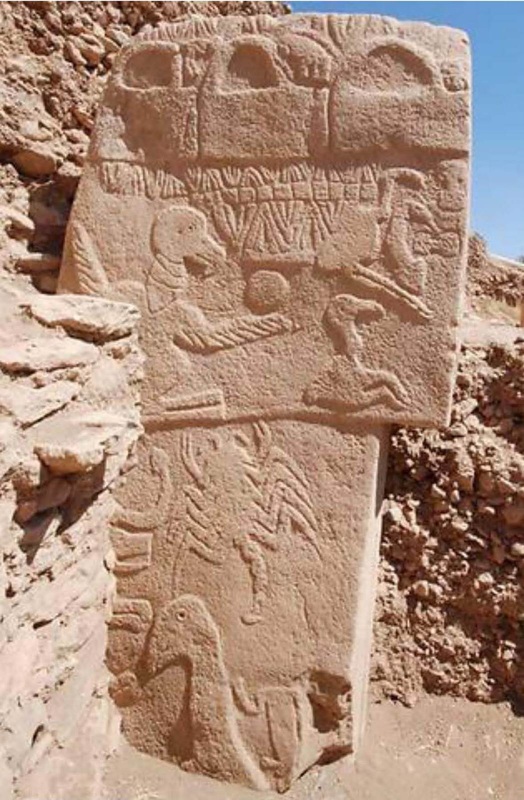There's more time between Gobekli Tepe and the Sumerian clay tablets [etched in 3300 B.C.] than from Sumer to today," says Gary Rollefson, an archaeologist at Whitman College in Walla Walla, Washington, who is familiar with Schmidt's work. "Trying to pick out symbolism from prehistoric context is an exercise in futility."
Still, archaeologists have their theories—evidence, perhaps, of the irresistible human urge to explain the unexplainable. The surprising lack of evidence that people lived right there, researchers say, argues against its use as a settlement or even a place where, for instance, clan leaders gathered. Hodder is fascinated that Gobekli Tepe's pillar carvings are dominated not by edible prey like deer and cattle but by menacing creatures such as lions, spiders, snakes and scorpions. "It's a scary, fantastic world of nasty-looking beasts," he muses. While later cultures were more concerned with farming and fertility, he suggests, perhaps these hunters were trying to master their fears by building this complex, which is a good distance from where they lived.
Danielle Stordeur, an archaeologist at the National Center for Scientific Research in France, emphasizes the significance of the vulture carvings. Some cultures have long believed the high-flying carrion birds transported the flesh of the dead up to the heavens. Stordeur has found similar symbols at sites from the same era as Gobekli Tepe just 50 miles away in Syria. "You can really see it's the same culture," she says. "All the most important symbols are the same."
For his part, Schmidt is certain the secret is right beneath his feet. Over the years, his team has found fragments of human bone in the layers of dirt that filled the complex. Deep test pits have shown that the floors of the rings are made of hardened limestone. Schmidt is betting that beneath the floors he'll find the structures' true purpose: a final resting place for a society of hunters.
Perhaps, Schmidt says, the site was a burial ground or the center of a death cult, the dead laid out on the hillside among the stylized gods and spirits of the afterlife. If so, Gobekli Tepe's location was no accident. "From here the dead are looking out at the ideal view," Schmidt says as the sun casts long shadows over the half-buried pillars. "They're looking out over a hunter's dream."
http://www.smithsonianmag.com/history/gobekli-tepe-the-worlds-first-temple-83613665/?page=3
Still, archaeologists have their theories—evidence, perhaps, of the irresistible human urge to explain the unexplainable. The surprising lack of evidence that people lived right there, researchers say, argues against its use as a settlement or even a place where, for instance, clan leaders gathered. Hodder is fascinated that Gobekli Tepe's pillar carvings are dominated not by edible prey like deer and cattle but by menacing creatures such as lions, spiders, snakes and scorpions. "It's a scary, fantastic world of nasty-looking beasts," he muses. While later cultures were more concerned with farming and fertility, he suggests, perhaps these hunters were trying to master their fears by building this complex, which is a good distance from where they lived.
Danielle Stordeur, an archaeologist at the National Center for Scientific Research in France, emphasizes the significance of the vulture carvings. Some cultures have long believed the high-flying carrion birds transported the flesh of the dead up to the heavens. Stordeur has found similar symbols at sites from the same era as Gobekli Tepe just 50 miles away in Syria. "You can really see it's the same culture," she says. "All the most important symbols are the same."
For his part, Schmidt is certain the secret is right beneath his feet. Over the years, his team has found fragments of human bone in the layers of dirt that filled the complex. Deep test pits have shown that the floors of the rings are made of hardened limestone. Schmidt is betting that beneath the floors he'll find the structures' true purpose: a final resting place for a society of hunters.
Perhaps, Schmidt says, the site was a burial ground or the center of a death cult, the dead laid out on the hillside among the stylized gods and spirits of the afterlife. If so, Gobekli Tepe's location was no accident. "From here the dead are looking out at the ideal view," Schmidt says as the sun casts long shadows over the half-buried pillars. "They're looking out over a hunter's dream."
http://www.smithsonianmag.com/history/gobekli-tepe-the-worlds-first-temple-83613665/?page=3

 RSS Feed
RSS Feed